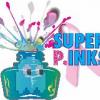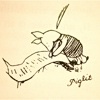Search the Community
Showing results for tags 'filling systems'.
-
I'm starting to think that my current grail pen might be a Sailor Pro Gear Realo with a Naginata Togi or Naginata Emperor. I've been driving myself a bit batty researching said pen, so here are a few questions that are bugging me: * Is the Realo a true piston filler just with a small ink capacity or is it a captive converter? I've seen it variously claimed to be either...the former's fine, I don't especially care about ink capacity and really like non-c/c filling systems. If it's a captive converter, though, I figure I might as well go with a c/c model. * Would it be prudent for someone who's never used a nice Sailor nib to skip straight to the Naginata series, or should I try out the normal 21kt nibs first?
-
Vacuum Force Feeding -- A Universal Filling Method
anderl posted a topic in Fountain & Dip Pens - First Stop
A disclaimer first: this is basically a repost of an idea mentioned by member suchan271 here, but in a thread on rollerballs, so it's well possible that vintage pen afficionados didn't see it. In fact, this filling method seems to work quite universally, with most types of fountain pens -- including some vintage pens whose inbuilt filling system is out of order for certain reasons (such as bad washer seals in vacuumfil pens). All one needs is a feed that allows ink to pass, and a tank that holds ink. Plus a syringe and a piece of PVC tube. In essence, the pen gets winded by external force, and when it gulps for air, it only finds ink to inhale. As referenced in suchan271's post, the method was devised, or at least publicised, by Kenneth Lee -- for use on a Pilot Varsity pen. His page shows two videos, which are also available on youtube, see video1 resp. video2. (The first of the two is more specific to the Varsity; only in the second does the connecting tube appear, and this makes the method much more widely applicable.) Here's a text description of the procedure: 1. One needs a piece of tube (rubber, PVC, or some flexible plastic) that fits the section of the pen snugly, and a syringe (minus needle) that fits just as snugly into the tube from the other end. 2. Fill the syringe with ink, but not to the brim: the first move of the procedure will be to pull the plunger further back. 3. Plug pen and syringe into the tube, hold with nib pointing upward. 4. Pull out the syringe plunger, then push in. Repeat until the pen is filled. 5. At the end, pull the plunger back, hold pen-tube-syringe aggregate so that syringe points upward, then unplug the pen from the tube. (This avoids having surplus ink soiling your hands.) In step 4, one creates a partial vacuum inside the pen, which then sucks the ink through the feed into the tank. Repeating the action really helps: pulling the plunger back out will remove the remaining air rather than the ink from the tank -- as long as the nib points upward. If the tube fits tightly enough, the procedure is surprisingly clean. Filling the syringe with no more ink than the pen will hold does of course help. An even cleaner, but slightly more fiddly, variant is shown in this video3 by Kenneth Lee. (Here the syringe merely serves as an air pump, without coming into contact with the ink.) Personally, I find this method ingenious. It is "conceptually elegant" in the sense that it works pretty universally and doesn't require any high tech components (I cut my piece of tube from an ancient shower hose I kept on the eminently sound principle of "you never know what it might be good for"). From an aesthetic point of view, it's of course less elegant and pleasing than operating a functioning vintage vacuum filler, or a smooth Pelikan piston, or a Conid bulkfiller. (And there is another aesthetic caveat: one has to decide beforehand whether a snugly fitting PVC tube might scratch the surface of the section. Didn't happen to me even with a fairly stiff piece of tube, but generally the softer the tube, the better.) I used the procedure successfully to ink two defunct vacuum fillers (one Sheaffer Balance, one Eversharp Doric) that wouldn't create enough suction anymore, but I also conducted water trials on various eyedropper pens, piston fillers, c/c fillers and even a sac filler: worked each time. My sincere thanks to suchan271 and to Kenneth Lee. I hope some of you find this useful, too. -
Some might say that anyone with more than ten fountain pens is a collector. If this is true then I might be that. I buy to use rather than to file away in a case or drawer, but in truth I only have ten or so inked at any one time. I've tried to do a purge and find that all I can manage is to offload what I have decided I will never repair or what I truly despise. On the other hand, having so many has been very useful in being able to narrow down what it is I really like and wondered if it is the same for others in the same boat as me. So, I thought I might outline what I like and enjoy through what ownership (of a rather silly amount of pens) has taught me, in the hope you might add your own musings. I feel I should add a disclaimer before I begin that these are 'my' musings and of course you may disagree very strongly with every last one of them! Jinhao: These taught me you can get very decent writers for very little money. For me they make great holiday pens. I like journal keeping while on holiday and won't be too upset if I mislay them, lose or break them. They also taught me that although I like a bit of weight to my pens, I don't like them to feel like they are made of lead or something you would have a gym workout with. Stipula: This taught me that just every once in a while a style over substance (or practical considerations) manufacturer can every now and again produce something truly great that can be missed by so many others based on past experience of other pens in their range. It also taught me that sometimes a pen can look awkward in a photograph (in terms of use, size, etc), but can be a really comfortable and pleasant pen in reality. Lamy: I now know that boring and ugly can sometimes be pleasant. Montblanc: I have been seduced by the wiles of near perfect balance and huge shiny nibs. It was also my first positive experience of feedback and how something like a nib can be distinctive in terms of 'feel'. Curiouser and curiouser! It also taught me that I love writing with fountain pens so much that I will occasionally spend a stupid amount of money on them. I try not to think about it too much. Waterman: I learnt the hard way that Western medium gold nibs that write like a felt tip are really not my thing. Sailor: Those that live in the land of the free, brave and whatever else seem to enjoy the level of feedback on Sailor's nibs. I find them unremarkable to look at and the nibs sail far too close to scratchy for my taste. The lesson was that feedback can sometimes be a very, very bad thing. Pilot: It is possible to come so, so close to absolute perfection - specifically for me in the 823. Balance, a nice glassy nib, perfect wetness of flow, great filling system, nice appearance. I keep twisting in between my fingers and thinking 'Damn, this is close to perfect'. Pelikan: Simplicity can be very, very beautiful. Visconti: Totally in your face and ridiculously over the top designs can also be beautiful and that springy, bouncy dreamtouch nibs can be a dream to use......when the quality control gets it right. Italix: Sometimes a pen everybody seems to love can turn out to be a Jinhao in disguise. I could go on, but I better leave some room for others to add their own thoughts. Overall though, looking at a whole lot of pens together it has taught me that it might be possible to spend just as much on ink, that experiencing a whole load of different pens from cheap to stupidly expensive is generally a good thing (but not for one's bank balance) and that using fountain pens somehow makes me have a truly deep appreciation for the art and miracle of writing.
- 65 replies
-
- fountain pens
- nibs
-
(and 5 more)
Tagged with:
-
Are the cartridge versions of some of the older classic pens considered inferior? If so, why?
- 35 replies
-

Sac Filling Systems Vs. Filling Systems Without Sacs
ChickenScratch posted a topic in Fountain & Dip Pens - First Stop
Since I started using and shopping for FP's last year, I've been staying away from pens with sac filling systems because they are made of a soft (probably easily damaged) material and I suspect they might prove to be higher maintenance and more likely to be in need of professional repair than pens that don't use sacs. Is there any truth in my impression? How long does a sac last before it should be replaced? Is it pretty easy to learn to do yourself? Is there an advantage to sac systems vs. non-sac systems? Are some sac systems more durable than others? -

Expensive Pens: What Makes Them Worth It?
AustinMalone1999 posted a topic in Fountain & Dip Pens - First Stop
So, the pen I most desire is a Edison Menlo, pump filler. However I won't be able to afford one for several years for sure, and the original Parker Vacs scare me. I know it's expensive but I love that shape and the filling system, and the ability to pick your own acrylics. What makes a pen worth it to you, personally, I like steel nibs just as well as gold nibs, if tuned properly. Is it purely aesthetics, purely the nib (softness, smoothness, plating?), or size? For me it is mainly shape and filling system, I have $75 for my Pump Filler, and I'll probably spring for a Newton Pen after that. Also, what is the most you can ever see yourself paying for a fountain pen. Please don't give any answers like ''the minimum should be $300 because quality is expensive'' this is simply not true for the majority of users. Thanks for your time and I look forward to reading your responses -

Does Onoto 22 Have Aerometric Fill System?
Love Pens posted a topic in Great Britain & Ireland - Europe
I have seen this pen recently and it appears to have an Aerometric filling system. It is suppose to be an Onoto 22 with an Onoto 33 nib I can not find any reference to Onoto having this type of filling system so I would like your opinion on this pen. Thankyou for your help on this. Love Pens









